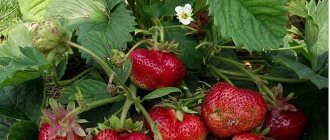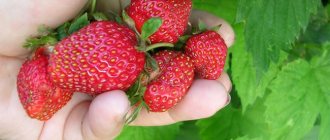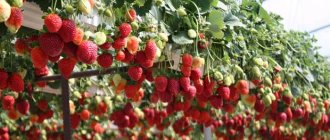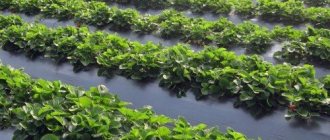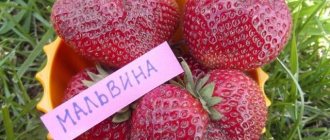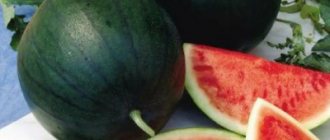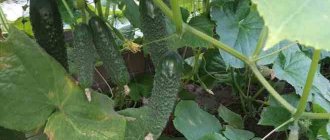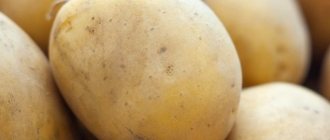The strawberry variety "Gigantella" was bred in Holland. It is one of the largest-fruited: the average weight of the berries is 50–60 g, some specimens reach the size of a small apple. But such a crop requires careful care. Otherwise, the fruits will be crushed and the yield will decrease.
"Gigantella" belongs to the mid-season type. Feels comfortable in regions with cold winters, resistant to rain and wind, and recurrent frosts. In the southern regions it will ripen from the end of May.
Characteristics table
Strawberries are not registered in the State Register of Russia, so there are no uniform standards for the variety. When describing the culture, one must rely on statements from Dutch farmers and producers of planting material, as well as reviews from Russian gardeners who grow Gigantella.
| Parameter | Characteristic |
| Ripening period | End of June-July |
| How many times does it bear fruit per season? | Once, not reusable |
| Yield per bush | High: 1.5–2.2 kg per bush |
| Berry size | Large, up to 50–60 g, in the southern regions reach 100–120 g |
| Form | Oval, flattened laterally |
| Color | Bright red |
| Taste qualities | Sweet and sour berries |
| Aroma | Strawberry with hints of pineapple |
| Pulp | Dense, juicy, without voids |
| Purpose of the variety | Universal |
| Drought resistance | Average |
| Frost resistance, winter hardiness | High, up to -25 °C |
| Disease resistance | Weak, susceptible to all strawberry diseases |
| Transportability of berries | 4.7 out of 5 points |
| Life cycle | 6–8 years |
| Tasting assessment | 3.4–4.5 points out of 5 |
Origin
“Gigantella” is considered a variety of Dutch selection. Many gardeners are of the opinion that the original name Gigantella Maxim was transformed into different versions: “Gigantella maxi” (that is, “maximum”) and “Maxim” (in the popular “translation”). Therefore, they believe that we are talking about the same variety. Others single out Maxim as a separate (“improved” and “modified”) version of Gigantella. In fact, all these disagreements are rather from the field of marketing and border on false advertising.
Packaging of planting material (seeds and seedlings) of Gigantella strawberries in various options offered by manufacturers
In their quest to grow “exotic” apple-sized strawberries, gardeners are often left disappointed. It is important to understand that any large-fruited strawberry variety better demonstrates its potential for yield, size and taste of berries in a mild southern climate on fairly light fertile soils. In the northern regions, in order to achieve good results, it is better to grow a heat-loving crop in protected soil (under film covers, in hotbeds, greenhouses). In addition, in order to bear large fruits, plants require constant care: regular watering, proper fertilizing, elimination of excess tendrils, weeding and loosening of the soil.
Powerful strawberry bushes "Gigantella" develop well and bear fruit in protected soil conditions
Detailed description of the variety
Initially, the variety was called Gigantella Maxim, but after appearing on the Russian market, the name was shortened to the common “Gigantella”. Some sellers even claim that Gigantella and Maxim are two separate varieties, but this is not true.
The description of the variety states that if agricultural practices are followed, “Gigantella” produces a bountiful harvest and is suitable for private and commercial cultivation. The fruits are used fresh and frozen, suitable for making jam and filling for pies.
Productivity
The yield of the variety is high; in areas with warm climates, strawberries produce 2.2 kg of berries per bush. If you follow agricultural techniques, you can harvest up to 3 kg. The first fruits appear in late May - mid-June (depending on the region). Ripen in portions. The variety is not remontant, there is no repeat wave.
Characteristics of berries and bush
Strawberry "Gigantella" is large-fruited. On average, the berries weigh 50–60 g, the largest specimens reach 100–120 g. The skin is rough, with prominent testes. The pulp is dense and tastes like pineapple with a strawberry flavor.
The bushes of the "Gigantella" variety are tall - up to 0.5 m. The root system is developed, exceeding 60 cm in diameter. Therefore, plants need to be planted at a large distance of 35 cm from each other. The leaves are large, corrugated, bright green. In the second year of cultivation, pink stains appear. Peduncles are strong, elastic, the average number on a bush is 25–30 pieces.
During the first wave of fruiting, the berries are large, after which they begin to become smaller. This is a normal phenomenon for Gigantella strawberries and has nothing to do with the composition of the soil, weather conditions or care habits.
Advantages and disadvantages
The description of the Gigantella variety shows that the crop has many advantages, for which gardeners value it. But there are also disadvantages.
Pros:
- high productivity;
- large berries with the smell of pineapple;
- resistance to weather changes and frosts;
- transportability;
- versatility of the variety.
Minuses:
- bushes take up a lot of space;
- immunity to diseases and pests is weak;
- the fruits become smaller every year;
- the largest berries may be watery;
- The variety requires regular watering and fertilizing.
What regions is it suitable for?
Strawberries "Gigantella" are characterized by high winter hardiness - the bushes can withstand down to -20 ° C without shelter. Therefore, it can be grown in all regions of Russia.
In the conditions of the Volga region, the middle zone, the Urals and Siberia, plantings are covered for the winter. If the protective layer is strong enough and the winter is snowy, the bushes can easily tolerate even extreme cold. Read more about the best strawberry varieties for growing in Siberia →
Peculiarities
Does not tolerate drought. With little watering, voids form inside. And in the absence of moisture, strawberries will not be able to produce a full harvest. This variety tolerates frost well, so it can survive the winter in open ground. Also, the Gigantella variety is resistant to pests and diseases. The fruits are sweet, juicy, with barely noticeable sourness and a pineapple flavor. They have different forms:
- ribbed;
- flattened;
- triangular;
- comb-shaped.
With a lack of sun, the top remains unripe. Due to the density of the berries, they do not wrinkle during transportation. Gigantella can be stored in the refrigerator for up to one week. At harvest, the weight of one strawberry reaches 120 grams, subsequently up to 60 grams. And the bush yields up to two kilograms, depending on growing conditions. In open ground from 1 kg, in a greenhouse - 2-2.5 kg. A sign of a fully ripe Gigantella is a scarlet color, a rough surface, covered with white seeds.
Best place for strawberries
Strawberries "Gigantella" are planted in a sunny, open area on the south or southwest side of buildings and other vegetation on the site. Choose a place protected from drafts, with low groundwater levels. Overmoistening of the soil leads to rotting of the roots and berries.
Large-fruited strawberries of the Gigantella variety require loose, fertile soil. The best option is loam, black soil. But with good care it will grow in less rich soil.
Successful neighbors and predecessors for the Gigantella strawberry:
- legumes;
- garlic;
- corn;
- carrot.
You should not plant rosettes after tomatoes, potatoes, cabbage, or sunflowers.
Agricultural technology for growing strawberry variety Gigantella
The place for this strawberry should be sunny, protected from gusts of cold winds, level, without stagnant moisture. The Gigantella variety is not planted in the lowlands. It is better if the soil on the site is light (loam, sandstone, black soil) and quite fertile.
Before planting, dig up the area, break up the clods, and apply fertilizer. Seedlings can be planted in the last ten days of April or in the first ten days of September. When applying fertilizers to strawberries, the main thing is not to apply a large amount of nitrogen fertilizers.
Transplanting Gigantella strawberries - video
The bushes grow quickly, but at the same time they produce a large number of tendrils, which must be removed immediately in order for the plants to ripen the fruits properly. The mustache for further propagation of the variety should be grown in the second half of summer, after fruiting has ended.
After the snow has melted, the bushes are inspected, plant debris and dry leaves are removed, and treated with fungicidal preparations for preventive purposes.
Fungicidal drug!
• Fungicide Antrakol - instructions for use and processing rules.
Onion peels are laid out between the rows, and then fertilizing is applied.
Pine needles or straw are laid around the bushes so that the introduced moisture evaporates more slowly.
Against possible pest attacks during the summer season, Gigantella bushes are treated with Fitosporin at least 5 times.
In the spring, compost is laid out under the bushes, which is a source of easily digestible nitrogen. During the bud blooming period, these strawberries will be fertilized with a solution of any potassium salt.
Important!
To increase the yield of Gigantella strawberry bushes, the plants are treated with a solution of boric acid during the flowering period.
After harvesting, be sure to feed this berry crop with a complex mineral fertilizer containing potassium and phosphorus.
Caring for strawberries after harvest - video
How to choose good strawberry seedlings
Strawberry seedlings "Gigantella" are purchased in specialized stores. This makes it less likely to buy plants of a different variety.
Requirements for quality seedlings:
- the leaves are large, rich green, without damage or spots;
- the root system is well developed, 8–10 cm long;
- The stems are tall and elastic.
Large-fruited strawberries of the Gigantella variety are best purchased in pots. After planting on the site, such seedlings are less sick and take root faster.
Description and characteristics of the variety
A characteristic feature that distinguishes this variety from other varieties of strawberries is the large size of ripe berries and their excellent taste characteristics. In addition, if you follow the recommended agricultural practices, Gigantella strawberries produce a bountiful harvest and tolerate winter well.
Thanks to all these qualities, this variety is considered elite and is grown not only in small plots for personal needs, but also on an industrial scale. A detailed description of Gigantella is given later in the article.
Features of landing and the best way
"Gigantella" can be grown from seeds and seedlings. The first method is long and laborious. When planting seeds in March, the seedlings will be ready only in July-August. Read more about how to grow strawberries from seeds →
In order not to waste a year and to get a guaranteed harvest of large berries, strawberries are propagated from seedlings.
According to reviews from experienced gardeners, it is better to plant Gigantella at the end of July. In the time remaining before frost, she will have time to take root in the new place and easily survive the winter.
Since strawberry bushes are large and spreading, the plants are planted at a distance of 35–40 cm. Plantings can be placed in a checkerboard pattern based on this pattern.
Or plant in a two-line pattern, leaving 80–90 cm between rows.
Another option is a linear scheme with row spacing of 60 cm.
The algorithm for planting Gigantella strawberries looks like this:
- Dig holes in the area according to the size of the seedling's root system.
- Pour water into them. Place the seedlings 15–30 minutes before rooting in Kornevin solution (10 g per 10 l).
- Place the plants in the holes, sprinkle with soil so that the root collar remains 1–2 cm above ground level.
- Pour water under the root and mulch.
Features of the variety
The main reason that gardeners love to grow this variety is its huge berries. Gigantela is currently breaking all records for size and weight. Other distinctive features of the variety:
- dense berries. Well suited for transportation;
- the berries will be ripe by the second week of June;
- bears fruit before the end of July;
- the variety is resistant to diseases and insect pests;
- begins to bloom early. The first flowering is observed with the arrival of May;
- the berries have a juicy core, a sweet taste, a bit like pineapple with a slight sourness;
- loves watering very much. A good harvest can be achieved with weekly watering;
- excellent frost resistance. The bushes are able to withstand winters in garden beds, even in Siberia and the Far East.
Features of care
The strawberry variety "Gigantella" is demanding of care, but in general the growing rules are standard. Plants are regularly watered, fed, and ensure that the soil remains loose and free of weeds.
Watering
Large-fruited strawberries are irrigated once a week, in hot weather - every three days. The earth should not dry out. 10 liters of water are consumed per square meter, and during fruiting - 20–25 liters.
Strawberries should be moistened in the morning or late evening with settled water. After moisture is absorbed, the soil is loosened and mulch is added.
Top dressing
Strawberry "Gigantella" needs regular feeding. It is recommended to apply them in the second year after planting.
| When to feed strawberries | What and how |
| After the first leaves appear | Watering with urea solution (15 g/10 l) 1 liter per bush |
| On the eve of flowering | 40 g of complex mineral fertilizer at the root |
| After harvest | Pouring a mixture of potassium sulfate (10 g), superphosphate (20 g) and wood ash (100 g) onto a bucket of water. 1 liter of solution is poured under the bush |
Reproduction
Strawberries of the Gigantella variety can be grown either vegetatively or by seeds.
In the first case, at the beginning of summer, the required number of layerings is added. After the roots appear, they are separated from the mother bush and planted in fertile soil. Periodically water and feed, mulch for the winter.
Strawberry seeds "Gigantella" are planted at the end of February, placing them in a container with soil or peat tablets. Cover with film and ensure the temperature is not lower than 20 °C. When 3 leaves appear, they are picked into separate containers and transferred to a room with a temperature of 15 °C. Seedlings with 5–6 leaves are planted in the ground.
The Gigantella variety is self-pollinating. But to increase productivity, it is recommended to pollinate manually using a brush. This simple procedure allows you to get a third more berries.
Trimming
Pruning is carried out as necessary - in the summer the mustache is removed, during harvest - excess flower stalks. In autumn, remove all dried leaves. If any part of the plant is affected by pests or disease, it should be pruned immediately.
You should not remove all strawberry leaves in the fall. It is recommended to leave healthy leaf blades on each bush, as they create additional thermal insulation.
Read more about how to prune strawberries in the fall so that they do not freeze and bear fruit well →
Preparing for winter
Despite the fact that the Gigantella variety is winter-hardy, in most regions plantings should be covered for the winter. When the temperature settles below 0 °C, straw or dry mullein is laid out on the site in a layer of 10–15 cm. In the Urals and Siberia, additional frames are installed on which burlap or non-woven material is stretched. After the snow melts, the protection is gradually removed.
Transfer
Strawberries "Gigantella" can grow in one place for 6-8 years, but already in the third year of life the berries become smaller. Therefore, plantings need to be updated more often.
For transplantation, horns are used, selecting for division bushes with young rhizomes (without lignification) or mustache seedlings.
Before rooting, seedlings are soaked for 20 minutes in a special solution: 0.5 tsp. copper sulfate, 1.5 tsp. salt per 5 liters of water. Afterwards they are washed with running water and planted in a permanent place.
Reproduction options and growing recommendations
For propagation, traditional methods of seedlings of Gigantella strawberries are used using daughter rosettes (stepchildren) or dividing bushes (horns). The method of germination from seeds is considered by some to be unacceptable or questionable, in which it is unknown how many seedlings sprout and what will grow from them. Others call seed propagation more correct, allowing one to obtain healthier varietal material. You can learn how to collect Gigantella strawberry seeds from the video:
The seedling planting schedule is chosen taking into account climatic and weather conditions. Basically, rosettes or horns are transplanted to a permanent place in the middle of summer, giving them the opportunity to take root well and get stronger before the onset of cold weather. High, level, well-lit areas, protected from drafts, are optimal for placing strawberries. Since the bushes are large in size, it is recommended to plant 2-4 plants per 1 m2, leaving a distance of at least 50-70 cm between them.
All peduncles are removed from bushes intended for propagation by stepsons, and the mustache is trimmed to obtain a harvest of berries.
The variety does not tolerate:
- heat and drought - inhibits fruit set, and possible “cooking” of the berries. Experts recommend using drip irrigation systems and mulching;
- shade, excess air humidity and nitrogen fertilizers (especially in the first year of growing season) - fruits ripen unevenly and are affected by gray rot;
- clayey and rocky soils - the root system gradually dries out, the berries become smaller, and the yield decreases.
Among the disadvantages of “Gigantella” is poor resistance to diseases: powdery mildew, Fusarium wilt, spots and rots, as well as all kinds of pests.
On bushes of this variety it is recommended to leave leaves (even withered ones) for the winter.
The variety is considered quite winter-hardy, capable of overwintering safely in open ground without shelter, but it is advised not to trim the leaves in the fall. They will help retain snow cover, protect the root collar from frost and infections, and get an earlier harvest. In the absence of overwintered young leaves, the bushes will begin to grow green mass “from scratch” in the spring and only then produce flower stalks. Removal of last year's leaves is carried out already during the fruiting period in order to improve ventilation and illumination of ripening berries, or immediately after it.
Pests and diseases
The Gigantella variety is susceptible to major strawberry diseases and pests. Therefore, in early April it is recommended to carry out preventive treatment with fungicides (per 10 liters of water):
- Bordeaux mixture - 150 ml;
- Fitosporin - 15 ml;
- Speed -4 ml;
- Tattu - 60 ml.
In summer, when aphids, weevils and other pests are detected, insecticides are sprayed:
- Confidor -1.5 g/10 l;
- Vertimek -3 ml/10 l;
- Match -8 ml/10 l;
- Fufanon -10 ml/10 l.
Watering and fertilizing
Plants need a lot of water for a good harvest, but excess moisture will cause fungal diseases, so watering should be rationed. Recommendations for proper watering:
- watering is done once a week, the ground on the site should be slightly wet;
- watering is done at the root; liquid settled on the leaves will cause sunburn;
- to moisten 1 m2 of land during the formation of ovaries, 10 liters of water are needed, and when filling berries, 25 liters;
- The best time for watering is early in the morning or evening, so that the water has time to soak into the ground;
- For watering you need to use settled, warm water. Cold water can cause root rot;
- Mulching allows you to retain moisture in the soil for a long time.
Possible problems
Reviews from gardeners show that in general the variety is unpretentious, although it is demanding in terms of lighting and soil composition. If you follow the rules of agricultural technology, there are no particular difficulties with cultivation. But in some cases, summer residents may encounter the following problems:
- The berries are watery and not very sweet. This happens during the first fruiting. Smaller fruits are tastier and sweeter.
- Fruit chopping. There is only one way to combat this feature of Gigantella - frequent renewal of plantings.
- Loss of bushes and reduced yield due to diseases and pests. Regular treatment with insecticides and spacious planting will help.
The strawberry variety “Gigantella” fully lives up to its name. The fruits are large, with an unusual aroma for the crop, and sell well on the market. Plants are frost-resistant and easily propagated by layering. The impression is spoiled by the variety’s susceptibility to diseases and the need for regular watering. If you do not follow the care recommendations, you may be left without crops and plants.
Reviews
Mila, 38 years old, Omsk
Judging by the reviews, Gigantella strawberries are so praised that I also wanted a berry that I could eat. It seems to have grown beautifully, but due to its large size, the berry does not have time to fully ripen. Either the top remains white or begins to rot. Many are empty inside and taste ordinary.
Victor, 54 years old, Chekhov
Gigantella Maxim has been growing with us for more than 5 years. The berries are large and very sweet. In recent years, they have become smaller, although we constantly care for the bushes: we use drip irrigation, feed them with slurry, clean them from weeds and excess tendrils, and treat them against diseases and pests. Apparently, it's time to update the landing.
Strawberry Gigantella: threats to plant development
If in the first year the strawberry variety Gigantella is quite resistant to pests and diseases, then from the second season the threats to development greatly increase. Let's look at them:
- Gray rot (fungus) affects Gigantella berries and is expressed as a gray coating, similar in appearance to mold, which subsequently leads to rotting of the berries. The bushes must be treated as quickly as possible, since the disease spreads quickly through the wind and through precipitation; with high humidity, the fungus progresses.
- Spotting (fungus) poses a direct threat to yield; visually these are purple spots. The main damage occurs on peduncles and stalks. The infection progresses under conditions of high humidity. Capable of reducing yields by up to sixty percent.
- Nematode micro parasite (worm) infects berries. They feed on life sap and then defecate into the fruits and the plant as a whole.
- Black rot is a fungal infection that leads to the death of roots. Infected bushes can be easily removed from the planting site.
- Root rot begins its attack on young roots, spreads to the stems of seedlings and then to the plant as a whole. As a result, the seedling dies.
- Powdery mildew is also a danger . It begins its spread from small foci on the leaves (dots), in a neglected state it covers the entire plant and the bush dies. This disease is a fungal pathogen; the infection survives the cold season under a covering of leaves.
- Fusarium wilt poses a great threat to young plants . Turns the plant into dust, from foliage to roots, as the plant is completely infected. The disease progresses in hot conditions, and the main carriers that transmit the infection are weeds.
Further care for berries
For good growth and fruiting, you must very carefully adhere to the rules of agricultural technology, otherwise this variety can be very capricious and will not give the expected result.
Watering
For good growth and fruiting of the Gigantella variety, watering is very important. The soil on which strawberries of this variety grow should always be slightly moist. The most optimal watering regime will be once every two days. But you should not overwater Gigantella; due to excessive amounts of moisture, fungal diseases can develop. A good solution would be to provide Gigantella with a drip irrigation system.
If there is insufficient moisture, the berries do not gain the required mass and the taste suffers, the fruits become sour and not so aromatic.
Fertilizers
Particular attention should be paid to feeding. If there are not enough nutrients in the soil, the taste of the berries and overall yield will suffer. It is very important to apply organic and mineral fertilizers on time.
The very first feeding should be done in the second year of growth. During this period, fertilizers with ammonium nitrate are applied. Already in the third year of growth, fertilizing with phosphorus and potassium chloride can be applied.
Fertilizer application should occur at the beginning of fruiting and at the end of harvest.
Loosening
Do not neglect the loosening process. Be sure to loosen the soil, thereby increasing its aeration and getting rid of weeds and small pests.
Mulching
Mulching is an important step when growing Gigantella. This is a great way to prevent pests from infesting bushes and berries. For these purposes, it is very effective to mulch the soil with plastic film; pine sawdust, hay, and even newspapers are also perfect.
Harvest and storage
Gigantella fruit harvest is mid-July, but again, it all depends on the region of growth.
The berries of this variety have excellent keeping quality and, if properly stored, can last quite a long time. It is best to store fruits in boxes with straw in a dark, cool place.
After fruiting
After the berry harvest has been harvested, it is necessary to take care of the bush itself. Care after fruiting includes loosening the soil, watering, timely application of fertilizers and preparation for winter.
Preparing for winter
To protect the plant from winter cold, it must be provided with proper shelter. The most important thing is mulching. For this, it is best to use mowed grass or leaves, but the use of pine branches and tree bark is allowed. It is worth noting that the bush itself does not need to be covered, only around it. In addition to natural materials, you can mulch with spunboard or cardboard.
Mulching for the winter is carried out in mid-autumn, at the beginning of October.
Diseases and pests
This berry is a godsend for pests and microorganisms. The list of diseases and pests of Gigantella strawberries is quite large.
Diseases:
Black rot: a fungal disease, manifested by the appearance of a plaque on the berries, which soon darkens, and the berries themselves lose their taste.
Septoria: the appearance of white spots with a dark outline on the leaves. Ultimately, the plant may die and spread the infection to neighboring bushes.
Fusarium: characterized by the gradual death of the plant, from the leaves to the root collar. Fusarium stops the development and growth of the bush.
Powdery Mildew: The most common type of fungus, it is described by the appearance of a silvery coating. As a result, the fungus completely destroys the bush.
Most strawberry diseases are fungal, and the best conditions for their development are warmth and humidity.
Pests:
- spider mite: a pest that feeds on plant sap; a distinctive feature of the parasite is the appearance of a thin cobweb;
- slugs: these parasites feast on the berries themselves. You can also notice slugs thanks to the mucus on or near the bush;
- Nematode: This pest damages the plant from the inside. It penetrates the stems or roots and stops the circulation of nutrients;
- Flower Beetle: This black beetle turns the strawberry bush into its breeding and feeding site. The pest lays offspring, which soon begin to devour the plant;
- birds: such pests also love to eat ripe berries. Because of them, the crop can suffer significantly.
Disease and pest control
The fight against diseases and parasites can be done in two ways. First: if the plant was slightly damaged or only the initial stages of damage were detected. In this case, you can use traditional means: decoctions, tinctures, powders. And second: if a disease or pest has completely affected the bush and folk remedies no longer help. In this case, it is necessary to use strong chemicals: fungicides, pesticides and insecticides.
Disease Prevention
In order to prevent diseases, it is recommended to spray Gigantella strawberries with fungicide preparations 4 times per season.
- The first treatment is carried out in May.
- The second treatment is carried out before flowering, during budding.
- The third time the strawberries are processed after they have finished flowering.
- For the fourth and last time during the season, strawberries are processed after harvesting.
Description
This is a mid-late variety. The plant's bush is powerful, with large peduncles and thick mustaches. Gigantella's root system is much larger than its relatives.
Strawberries are really huge. There are specimens that weigh 130 grams. But usually they acquire this size in the first year of fruiting. Further, the average weight of ripe strawberries varies around 80 grams.
The taste of the berries is excellent. They are juicy, sweet, with a characteristic strawberry aroma.
Productivity is average. According to the standard, up to 1 kg of fruit is harvested from one bush.
The variety is ideal for freezing, since under such conditions it does not lose its taste at all.
The main advantages of Maxi include:
- Huge dimensions of the fruit.
- Good yield.
- High demand in the market.
- Pleasant taste.
Speaking of winter hardiness and immunity, Gigantella is not very happy here. Frost resistance indicators are average, and it is not protected from diseases, especially in unfavorable growing conditions.
Advantages and disadvantages of the Gigantella variety
Like any variety of any plant, the Gigantella variety has its pros and cons, which you should know about when deciding to plant strawberries of this variety in your garden.
Advantages.
- Berry size.
- High taste qualities of fruits.
- High yield.
- Early maturation.
- Good frost resistance.
- High degree of keeping quality.
- Good transportability.
- Versatility in cooking.
Flaws.
- Requires strict adherence to the rules of agricultural technology.
- Doesn't like drought.
- It has low resistance to diseases and pests.
- Shrinking of fruits in the second and subsequent years of fruiting.


